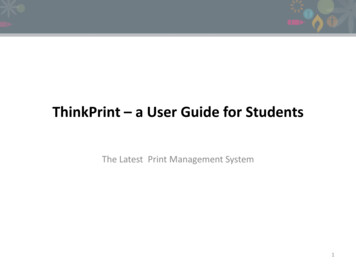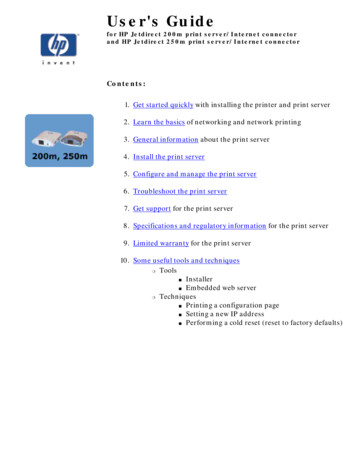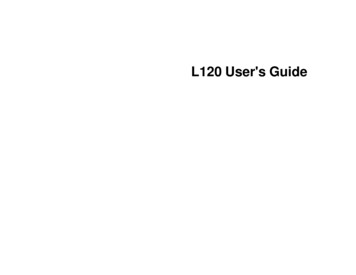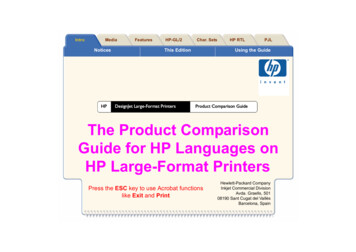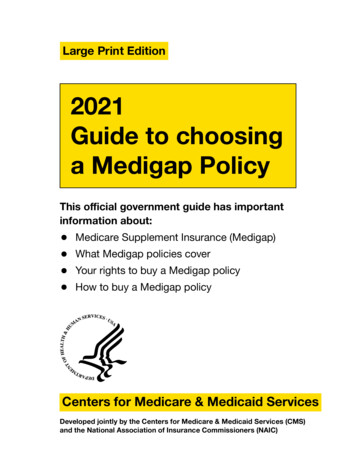
Transcription
Large Print Edition2021Guide to choosinga Medigap PolicyThis official government guide has importantinformation about: Medicare Supplement Insurance (Medigap)What Medigap policies coverYour rights to buy a Medigap policyHow to buy a Medigap policyCenters for Medicare & Medicaid ServicesDeveloped jointly by the Centers for Medicare & Medicaid Services (CMS)and the National Association of Insurance Commissioners (NAIC)
Who should read this guide?If you’re thinking about buying a Medicare SupplementInsurance (Medigap) policy or you already have one, thisguide can help you understand how it works.Important information about this guideThe information in this guide describes the MedicareProgram at the time this guide was printed. Changesmay occur after printing. Visit Medicare.gov, or call1 800 633 ‑ 4227 to get the most current information.TTY users can call 1 877 486 ‑ 2048.The “2021 Guide to Choosing a Medigap Policy” isn’t alegal document. Official Medicare Program legal guidanceis contained in the relevant statutes, regulations, andrulings.This product was produced at U.S. taxpayer expense.
1Table of ContentsSection 1: Medicare BasicsWhat’s Medicare? 5The different parts of Medicare 5Your Medicare coverage options 7Medicare & the Health Insurance Marketplace 8Find more information about Medicare 9Section 2: Medigap BasicsWhat’s a Medigap policy? 11What Medigap policies cover 13What Medigap policies don’t cover 17Types of coverage that are NOT Medigap policies 17What types of Medigap policies can insurancecompanies sell? 18What do I need to know if I want to buy a Medigappolicy? 19When’s the best time to buy a Medigap policy? 21
2 Table of ContentsWhy is it important to buy a Medigap policy when I’m firsteligible? 24How do insurance companies set prices for Medigappolicies? 26Comparing Medigap costs 30What’s Medicare SELECT? 32How does Medigap help pay my Medicare Part Bcosts? 32Section 3: Your Right to Buy a Medigap PolicyWhat are guaranteed issue rights? 35When do I have guaranteed issue rights? 36Can I buy a Medigap policy if I lose my health carecoverage? 44For more information about Medigap rights 45
3 Table of ContentsSection 4: Steps to Buying a Medigap PolicyStep‑by‑step guide to buying a Medigap policy 47Section 5: If You Already Have a Medigap PolicySwitching Medigap policies 60Losing Medigap coverage 67Medigap policies & Medicare drug coverage 68Section 6: Medigap Policies for People with aDisability or ESRDMedigap policies for people under 65 and eligible forMedicare because of a disability or End‑Stage RenalDisease (ESRD) 73Section 7: Medigap Coverage in Massachusetts,Minnesota, & WisconsinMassachusetts benefits 78Minnesota benefits 80Wisconsin benefits 84
4 Table of ContentsSection 8: For More InformationWhere to get more information 87How to get help with Medicare & Medigap questions 88State Health Insurance Assistance Program (SHIP) &State Insurance Department 89Section 9: DefinitionsWhere underlined words are defined 93 End of Page
5Section 1:Medicare BasicsWhat’s Medicare?Medicare is health insurance for people 65 or older,certain people under 65 with disabilities, and people ofany age with End‑Stage Renal Disease (ESRD) (permanentkidney failure requiring dialysis or a kidney transplant).The different parts of MedicareThe different parts of Medicare help cover specificservices.Part A (Hospital Insurance) helps cover: Inpatient care in hospitalsSkilled nursing facility careHospice careHome health careUnderlined words are defined on pages 93 – 97.
6 Section 1: Medicare BasicsPart B (Medical Insurance) helps cover: Services from doctors and other health care providersOutpatient careHome health careDurable medical equipment (like wheelchairs, walkers,hospital beds, and other equipment)Many preventive services (like screenings, shots orvaccines, and yearly “Wellness” visits)Part D (Drug coverage)Helps cover cost of prescription drugs (including manyrecommended shots or vaccines).Plans that offer Medicare drug coverage are run by privateinsurance companies that follow rules set by Medicare. End of Page
7 Section 1: Medicare BasicsYour Medicare coverage optionsWhen you first enroll in Medicare and during certain timesof the year, you can choose how you get your Medicarecoverage. There are 2 main ways to get Medicare:Original Medicare Includes Medicare Part A (Hospital Insurance) andPart B (Medical Insurance).If you want drug coverage, you can join a separateMedicare drug plan.To help pay your out‑of‑pocket costs in OriginalMedicare (like your 20% coinsurance), you can alsobuy supplemental coverage.Can use any doctor or hospital that takes Medicare,anywhere in the U.S.Medicare Advantage (also known as Part C)An “all in one” alternative to Original Medicare. These“bundled” plans include Part A, Part B, and usuallyPart D. Plans may have lower out‑of‑pocket costs thanOriginal Medicare.In most cases, you’ll need to use doctors who are inthe plan’s network.Most plans offer extra benefits that Original Medicaredoesn’t cover—like vision, hearing, dental, and more.
8 Section 1: Medicare BasicsMedicare & the Health Insurance Marketplace 1If you have coverage through an individual Marketplaceplan (not through an employer), you should enroll inMedicare during your Initial Enrollment Period to avoid therisk of a delay in Medicare coverage and the possibility ofa Medicare late enrollment penalty. For most people, theirInitial Enrollment Period is the 7‑month period that starts3 months before the month they turn 65, includes themonth they turn 65, and ends 3 months after the monththey turn 65.You can keep your Marketplace plan without penalty untilyour Medicare coverage starts. Once you’re consideredeligible for premium‑free Part A, you won’t qualify for helppaying your Marketplace plan premiums or other costs.If you continue to get help paying your Marketplace planpremium after you have Medicare, you may have to payback some or all of the help you got when you file yourtaxes.1 “Health Insurance Marketplace ” is a registeredtrademark of the U.S. Department of Health & HumanServices.
9 Section 1: Medicare BasicsVisit HealthCare.gov to find your state’s Marketplace,or learn how to end your Marketplace financial help orplan to avoid a gap in coverage. You can also call theMarketplace Call Center at 1 800 318 ‑ 2596. TTY userscan call 1 855 889 ‑ 4325.Note: Medicare isn’t part of the Marketplace. TheMarketplace doesn’t offer Medicare Supplement Insurance(Medigap) policies, Medicare Advantage Plans, orMedicare drug coverage (Part D).Find more information about MedicareTo learn more about Medicare: Visit Medicare.gov.Look at your “Medicare & You” handbook.Get free, personalized counseling from yourState Health Insurance Assistance Program (SHIP).(See pages 89 – 92.)Call 1 800 633 ‑ 4227. TTY users can call1 877 486 ‑ 2048.Find and compare health and drug plans atMedicare.gov/plan‑compare.
10Notes
11Section 2:Medigap BasicsWhat’s a Medigap policy?A Medicare Supplement Insurance (Medigap) policy is aninsurance policy that helps fill “gaps” in Original Medicareand is sold by private companies. Original Medicare paysfor much, but not all, of the cost for covered health careservices and supplies. Medigap policies can help payfor some of the costs that Original Medicare doesn’t, likecopayments, coinsurance, and deductibles.Some Medigap policies also cover certain benefitsOriginal Medicare doesn’t cover, like emergency foreigntravel expenses. Medigap policies don’t cover yourshare of the costs under other types of health coverage,including Medicare Advantage Plans, stand‑aloneMedicare drug plans, employer/union group healthcoverage, Medicaid, or TRICARE.Underlined words are defined on pages 93 – 97.
12 Section 2: Medigap BasicsIf you have Original Medicare and a Medigappolicy, Medicare will pay its share of theMedicare‑approved amounts for covered health carecosts. Then, your Medigap policy pays its share. Medicaredoesn’t pay any of the costs of buying a Medigap policy.A Medigap policy is different from a Medicare AdvantagePlan because those plans are another way to get yourPart A and Part B benefits, while a Medigap policy onlyhelps pay for the costs that Original Medicare doesn’tcover. Insurance companies generally can’t sell you aMedigap policy if you have coverage through a MedicareAdvantage Plan or Medicaid.All Medigap policies must follow federal and state lawsdesigned to protect you, and policies must be clearlyidentified as “Medicare Supplement Insurance.” Medigappolicies are standardized, and in most states are namedby letters, Plans A – N. Each standardized Medigap policyunder the same plan letter must offer the same basicbenefits, no matter which insurance company sells it.Cost is usually the only difference between Medigappolicies with the same plan letter sold by differentinsurance companies.
13 Section 2: Medigap BasicsWhat Medigap policies coverThe information on pages 15 – 16 gives you aquick look at the standardized Medigap plansavailable. For more information to help find apolicy that works for you, visit plans. If youneed help comparing and choosing a policy, call yourState Health Insurance Assistance Program (SHIP).See pages 89 – 92 for your state’s phone number. Every insurance company selling Medigap policiesmust offer Plan A. If they want to offer policies inaddition to Plan A, they must also offer either Plan C orPlan F to individuals who aren’t new to Medicare andeither Plan D or Plan G to individuals who are new toMedicare. Not all types of Medigap policies may beavailable in your state.Plans D and G with coverage starting on or afterJune 1, 2010, have different benefits than Plans D orG bought before June 1, 2010.Plans E, H, I, and J are no longer sold, but if youalready have one, you can generally keep it.
14 Section 2: Medigap Basics Since January 1, 2020, Medigap plans sold to peoplenew to Medicare aren’t allowed to cover the Part Bdeductible. Because of this, Plans C and F areno longer available to people who were “new toMedicare” on or after January 1, 2020. If you already have either of these 2 plans (or thehigh deductible version of Plan F) or you werecovered by one of these plans before January 1,2020, you’ll be able to keep your plan. If you wereeligible for Medicare before January 1, 2020 but notyet enrolled, you may be able to buy one of theseplans.For this situation, people “new to Medicare” arepeople who turned 65 on or after January 1, 2020,and people who got Medicare Part A (HospitalInsurance) on or after January 1, 2020.In Massachusetts, Minnesota, and Wisconsin,Medigap policies are standardized in a different way.(See pages 78 – 85.) In some states, you may beable to buy another type of Medigap policy calledMedicare SELECT. Medicare SELECT are standardizedplans that may require you to see certain providers andmay cost less than other Medigap plans. (See page 32.)
15 Section 2: Medigap BasicsBelow is basic information about the different benefitsthat Medigap plans cover. If a percentage appears, theMedigap plan covers that percentage of the benefit, andyou must pay the rest. If a box is blank, the plan doesn’tcover that benefit.Medicare Part A coinsurance and hospital costs(up to an additional 365 days after Medicarebenefits are used) covers 100% in plans A, B, C, D,F*, G*, K, L, M, and N. Medicare Part B coinsurance or copayment covers100% in plans A, B, C, D, F*, G*, M and N***. Covers50%in plan K and 75% in plan L.Blood (first 3 pints) covers 100% in plans A, B, C, D,F*, G*, M, and N. Covers 50% in plan K and 75% inplan L.Part A hospice care coinsurance or copaymentcovers 100% in plans A, B, C, D, F*, G*, M, and N.Covers 50% in plan K and 75% in plan L.Skilled nursing facility care coinsurance covers100% in plans C, D, F*, G*, M, and N. Covers 50% inplan K and 75% in plan L.Part A deductible covers 100% in plans B, C, D, F*,G*, and N. Covers 50% in plan K and M and 75% inplan L.Part B deductible covers 100% in plans C and F*.
16 Section 2: Medigap Basics Part B excess charges covers 100% in plans F*and G.Foreign travel emergency (up to plan limits) covers80% in plans C, D, F*, G*, M, and N.Out‑of‑pocket limit for plan K** in 2021 is 6,220.Out‑of‑pocket limit for plan L** in 2021 is 3,110.* Plans F and G also offer a high‑deductible plan insome states (Plan F isn’t available to people newto Medicare on or after January 1, 2020.) If youget the high‑deductible option, you must pay forMedicare‑ covered costs (coinsurance, copayments,and deductibles) up to the deductible amount of 2,370 in 2021 before your policy pays anything, andyou must also pay a separate deductible ( 250 peryear) for foreign travel emergency services.** Plans K and L show how much they’ll pay for approvedservices before you meet your out‑of‑pocket yearly limitand your Part B deductible ( 203 in 2021). After youmeet these amounts, the plan will pay 100% of yourcosts for approved services for the rest of the calendaryear.*** Plan N pays 100% of the Part B coinsurance, exceptfor a copayment of up to 20 for some office visits andup to a 50 copayment for emergency room visits thatdon’t result in an inpatient admission.
17 Section 2: Medigap BasicsWhat Medigap policies don’t coverGenerally, Medigap policies don’t cover long‑term care(like non‑skilled care you get in a nursing home), visionor dental care, hearing aids, eyeglasses, or private‑dutynursing.Types of coverage that are NOT Medigappolicies Medicare Advantage Plans (also known as Part C)Medicare drug plan (Part D)MedicaidEmployer or union plans, including the FederalEmployees Health Benefits Program (FEHBP)TRICAREVeterans’ benefitsLong‑term care insurance policiesIndian Health Service, Tribal, and Urban Indian HealthplansHealth plans sold in the Health Insurance Marketplace
18 Section 2: Medigap BasicsWhat types of Medigap policies caninsurance companies sell?In most cases, Medigap insurance companies can sellyou only a “standardized” Medigap policy. All Medigappolicies must have specific benefits, so you can comparethem easily. If you live in Massachusetts, Minnesota, orWisconsin, see pages 78 – 85.Insurance companies that sell Medigap policies don’t haveto offer every Medigap plan. Each insurance companydecides which Medigap plans it wants to sell, althoughfederal and state laws might affect which ones they canoffer.In some cases, an insurance company must sell you aMedigap policy if you want one, even if you have healthproblems. Here are certain times that you’re guaranteedthe right to buy a Medigap policy: When you’re in your Medigap Open EnrollmentPeriod. (See pages 21 – 22.)If you have a guaranteed issue right.(See pages 35 – 43.)
19 Section 2: Medigap BasicsYou may be able to buy a Medigap policy at other times,but the insurance company can deny you a Medigappolicy based on your health. Also, in some cases, itmay be illegal for the insurance company to sell you aMedigap policy (like if you already have Medicaid or aMedicare Advantage Plan).What do I need to know if I want to buy aMedigap policy? You must have Medicare Part A (Hospital Insurance)and Medicare Part B (Medical Insurance).If you have a Medicare Advantage Plan but areplanning to return to Original Medicare, you can applyfor a Medigap policy before your coverage ends. TheMedigap insurance company can sell it to you as longas you’re leaving the Medicare Advantage Plan. Askthat the new Medigap policy start when your MedicareAdvantage Plan enrollment ends, so you’ll havecontinuous coverage.You pay the private insurance company a premium foryour Medigap policy in addition to the monthly Part Bpremium you pay to Medicare.A Medigap policy only covers one person. If you andyour spouse both want Medigap coverage, you eachwill have to buy separate Medigap policies.
20 Section 2: Medigap Basics When you have your Medigap Open EnrollmentPeriod, you can buy a Medigap policy from anyinsurance company that’s licensed in your state.Any new Medigap policy issued since 1992 isguaranteed renewable even if you have healthproblems. This means the insurance company can’tcancel your Medigap policy as long as you stayenrolled and pay the premium.Different insurance companies may charge differentpremiums for the same exact Medigap plan type.As you shop for a policy, be sure you’re comparingpolicies under the same plan type (for example,compare Plan A from one company with Plan A fromanother company).Some states may have laws that give you additionalprotections.Although some Medigap policies sold in the pastcovered prescription drugs, Medigap policies sold afterJanuary 1, 2006 aren’t allowed to include prescriptiondrug coverage. If you want drug coverage, you can joina Medicare drug plan offered by private companiesapproved by Medicare. (See pages 5 – 7.) To learnabout Medicare drug coverage, visit Medicare.gov,or call 1 800 633 ‑ 4227. TTY users can call1 877 486 ‑ 2048.
21 Section 2: Medigap BasicsWhen’s the best time to buy a Medigappolicy?The best time to buy a Medigap policy is during yourMedigap Open Enrollment Period. This period lastsfor 6 months and begins on the first day of the monthyou’re both 65 or older and enrolled in Medicare Part B.Some states have additional Open Enrollment Periods,including those for people under 65. If you’re under 65and have Medicare because of a disability or End‑StageRenal Disease (ESRD), you might not be able to buy theMedigap policy you want, or any Medigap policy, until youturn 65. (See page 73 for more information.)During the Medigap Open Enrollment Period, an insurancecompany can’t use medical underwriting to decidewhether to accept your application. This means theinsurance company can’t do any of these because of yourhealth problems: Refuse to sell you any Medigap policy it offersCharge you more for a Medigap policy than theycharge someone with no health problemsMake you wait for coverage to start (except asexplained on the next page)
22 Section 2: Medigap BasicsWhile the insurance company can’t make you wait foryour coverage to start, it may be able to make you waitfor coverage related to a pre‑existing condition. Apre‑existing condition is a health problem you have beforethe date a new insurance policy starts. In some cases,the Medigap insurance company can refuse to cover yourout‑of‑pocket costs for these pre‑existing health problemsfor up to 6 months. This is called a “pre‑existing conditionwaiting period.” After 6 months, the Medigap policy willcover the pre‑existing condition.Coverage for a pre‑existing condition can only beexcluded if the condition was treated or diagnosed within6 months before your Medigap policy coverage starts.This is called the “look‑back period.” Remember, forMedicare‑covered services, Original Medicare will stillcover the condition, even if the Medigap policy won’t,but you’re responsible for the Medicare coinsurance orcopayment.Creditable coverageIt’s possible to avoid or shorten your waiting period for apre‑existing condition if: You buy a Medigap policy during your 6‑monthMedigap Open Enrollment Period.You’re replacing certain kinds of health coverage thatcount as “creditable coverage”.
23 Section 2: Medigap BasicsPrior creditable coverage is generally any other healthcoverage you recently had before applying for a Medigappolicy. If you’ve had at least 6 months of continuousprior creditable coverage, the Medigap insurancecompany can’t make you wait before it covers yourpre‑existing conditions.There are many types of health care coverage that maycount as creditable coverage for Medigap policies, butthey’ll only count if you didn’t have a break in coverage formore than 63 days.Your Medigap insurance company can tell you ifyour previous coverage will count as creditablecoverage for this purpose. You can also call yourState Health Insurance Assistance Program (SHIP).(See pages 89 – 92.)If you buy a Medigap policy when you have aguaranteed issue right (also called “Medigapprotection”), the insurance company can’t use apre‑existing condition waiting period. See pages 35 – 43for more information about guaranteed issue rights.
24 Section 2: Medigap BasicsWhy is it important to buy a Medigap policywhen I’m first eligible?During your Medigap Open Enrollment Period, youhave the right to buy any Medigap policy offered inyour state. In addition, you generally will get betterprices and more choices among policies. If you applyfor Medigap coverage after your Open EnrollmentPeriod, there’s no guarantee that an insurancecompany will sell you a Medigap policy if you don’tmeet the medical underwriting requirements, unlessyou’re eligible for guaranteed issue rights (Medigapprotections) because of one of the situations listed onpages 35 – 43.It’s also important to understand that your Medigaprights may depend on when you choose to enroll inMedicare Part B. If you’re 65 or older, your Medigap OpenEnrollment Period begins when you enroll in Part B, and itcan’t be changed or repeated. After your Medigap OpenEnrollment Period ends, you may be denied a Medigappolicy or charged more for a Medigap policy due to pastor present health problems.
25 Section 2: Medigap BasicsIn most cases, it makes sense to enroll in Part B and buya Medigap policy when you’re first eligible for Medicare,because you might otherwise have to pay a Part Blate enrollment penalty and might miss your 6‑monthMedigap Open Enrollment Period. However, there areexceptions if you have employer coverage.Employer coverageIf you have group health coverage through an employeror union, because either you or your spouse is currentlyworking, you may choose to wait to enroll in Part B.Benefits based on current employment often providecoverage similar to Part B, so you wouldn’t want to payfor Part B before you need it, and your Medigap OpenEnrollment Period might expire before a Medigap policywould be useful. When the employer coverage ends, you’llget a chance to enroll in Part B without a late enrollmentpenalty, which means your Medigap Open EnrollmentPeriod will start when you’re ready to take advantageof it. If you or your spouse is still working and you havecoverage through an employer, contact your employeror union benefits administrator to find out how yourinsurance works with Medicare. See page 44 for moreinformation.
26 Section 2: Medigap BasicsHow do insurance companies set prices forMedigap policies?Each insurance company decides how it’ll set the price,or premium, for its Medigap policies. The way they setthe price affects how much you pay now and in the future.Each Medigap policy can be priced or “rated” in one of3 ways:1. Community‑rated (also called “no‑age‑rated”)2. Issue‑age‑rated (also called “entry‑age‑rated”)3. Attained‑age‑ratedEach of these ways of pricing Medigap policies isdescribed on the next 3 pages. The examples show howyour age affects your premiums, and why it’s importantto look at how much the Medigap policy will cost younow and in the future. The amounts in the examplesaren’t actual costs. Other factors like where you live,medical underwriting, and discounts can also affect theamount of your premium.
27 Section 2: Medigap BasicsCommunity‑rated (also called “no‑age‑rated”)How it’s pricedGenerally the same premium is charged to everyone whohas the Medigap policy, regardless of age or gender.What this pricing may mean for youYour premium isn’t based on your age. Premiums may goup because of inflation and other factors but not becauseof your age.ExamplesMr. Smith is 65. He buys a Medigap policy and pays a 165 monthly premium.Mrs. Perez is 72. She buys the same Medigap policy asMr. Smith. She also pays a 165 monthly premium. End of Page
28 Section 2: Medigap BasicsIssue‑age‑rated (also called “entry age‑rated”)How it’s pricedThe premium is based on the age you are when you buy(are “issued”) the Medigap policy.What this pricing may mean for youPremiums are lower for people who buy at a younger ageand won’t change as you get older. Premiums may go upbecause of inflation and other factors but not because ofyour age.ExamplesMr. Han is 65. He buys a Medigap policy and pays a 145monthly premium.Mrs. Wright is 72. She buys the same Medigap policy asMr. Han. Since she is older when she buys it, her monthlypremium is 175. End of Page
29 Section 2: Medigap BasicsAttained‑age‑ratedHow it’s pricedThe premium is based on your current age (the ageyou’ve “attained”), so your premium goes up as you getolder.What this pricing may mean for youPremiums are low for younger buyers but go up asyou get older. They may be the least expensive at first,but they can eventually become the most expensive.Premiums may also go up because of inflation and otherfactors.ExamplesMrs. Anderson is 65. She buys a Medigap policy and paysa 120 monthly premium. Her premium will go up eachyear: At 66, her premium goes up to 126.At 67, her premium goes up to 132.Mr. Dodd is 72. He buys the same Medigap policy as Mrs.Anderson. He pays a 165 monthly premium. His premiumis higher than Mrs. Anderson’s because it’s based on hiscurrent age. Mr. Dodd’s premium will go up each year: At 73, his premium goes up to 171.At 74, his premium goes up to 177.
30 Section 2: Medigap BasicsComparing Medigap costsAs discussed on the previous pages, the cost of Medigappolicies can vary widely. There can be big differencesin the premiums that different insurance companiescharge for exactly the same coverage. As you shop fora Medigap policy, be sure to compare Medigap plan typeswith the same letter, and consider the type of pricingeach insurance company uses. (See pages 26 – 29.)For example, compare Plan G from one company withPlan G from another company. Although this guide can’tgive actual costs of Medigap policies, you can get thisinformation by calling insurance companies or yourState Health Insurance Assistance Program (SHIP).(See pages 89 – 92.)You can also find out which insurance companies sellMedigap policies in your area by visiting plans.The cost of your Medigap policy may also depend onwhether the insurance company: Offers discounts (like discounts for women,non‑smokers, or people who are married; discountsfor paying yearly; discounts for paying your premiumsusing electronic funds transfer; or discounts formultiple policies).
31 Section 2: Medigap Basics Uses medical underwriting, or applies adifferent premium when you don’t havea guaranteed issue right or aren’t in aMedigap Open Enrollment Period.Sells Medicare SELECT policies that may requireyou to use certain providers. If you buy this type ofMedigap policy, your premium may be less. (Seepage 32.)Offers a “high‑deductible option” for Plans F orG. If you buy Plans F or G with a high‑deductibleoption, you must pay the first 2,370 of deductibles,copayments, and coinsurance (in 2021) for coveredservices not paid by Medicare before the Medigappolicy pays anything. You must also pay a separatedeductible ( 250 per year) for foreign travel emergencyservices.End of Page
32 Section 2: Medigap BasicsWhat’s Medicare SELECT?Medicare SELECT is a type of Medigap policy sold insome states that requires you to use hospitals and, insome cases, doctors within its network to be eligible forfull insurance benefits (except in an emergency). MedicareSELECT can be offered as any of the standardizedMedigap plans. (See pages 15 – 16.) These policiesgenerally cost less than other Medigap policies. However,if you don’t use a Medicare SELECT hospital or doctor fornon‑emergency services, you’ll have to pay some or all ofwhat Medicare doesn’t pay. Medicare will pay its share ofapproved charges no matter which hospital or doctor youchoose.How does Medigap help pay my MedicarePart B costs?In most Medigap policies, you agree to have the Medigapinsurance company get your Part B claim informationdirectly from Medicare. Then, they pay the doctor directlywhatever amount is owed under your policy. SomeMedigap insurance companies also provide this servicefor Medicare Part A claims.
33 Section 2: Medigap BasicsIf your Medigap insurance company doesn’t providethis service, ask your doctors if they participate inMedicare. Participating providers have agreed to acceptassignment for all Medicare‑covered services. If yourdoctor participates, the Medigap insurance company isrequired to pay the doctor directly if you request. If yourdoctor doesn’t participate but still accepts Medicare, youmay be asked to pay the coinsurance amount at thetime of service. In these cases, your Medigap insurancecompany may pay you directly according to policy limits.Check with your Medigap policy for more details.If you have any questions about Medigap claim filing, call1 800 633 ‑ 4227. TTY users can call 1 877 486 ‑ 2048. End of Page
34Notes
35Section 3: YourRight to Buy aMedigap PolicyWhat are guaranteed issue rights?Guaranteed issue rights are your rights to buy certainMedigap policies in certain situations outside of yourMedigap Open Enrollment Period. In these situations,an insurance company must: Sell you a Medigap policyCover all your pre‑existing health conditionsNot charge you more for a Medigap policy regardlessof past or present health problemsIf you live in Massachusetts, Minnesota, or Wisconsin, youhave guaranteed issue rights to buy a Medigap policy, butthe Medigap policies are different. See pages 78 – 85 foryour Medigap policy choices.Underlined words are defined on pages 93 – 97.
36 Section 3: Your Right to Buy a Medigap PolicyWhen do I have guaranteed issue rights?In most cases, you have a guaranteed issue rightwhen you have other health coverage that changesin some way, like when yo
Section 4: Steps to Buying a Medigap PolicyStep‑by‑step guide to buying a Medigap policy _ 47 . Step‑by‑step guide to buying a Medigap policy _ 47 . Section 5: If You Already Have a Medigap PolicySwitching Medigap policies _ 60Losing Medigap coverage _ 67Medigap policies & Medicare drug coverage _ 68 . Switching Medigap policies _ 60
